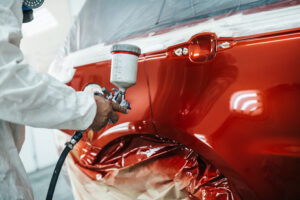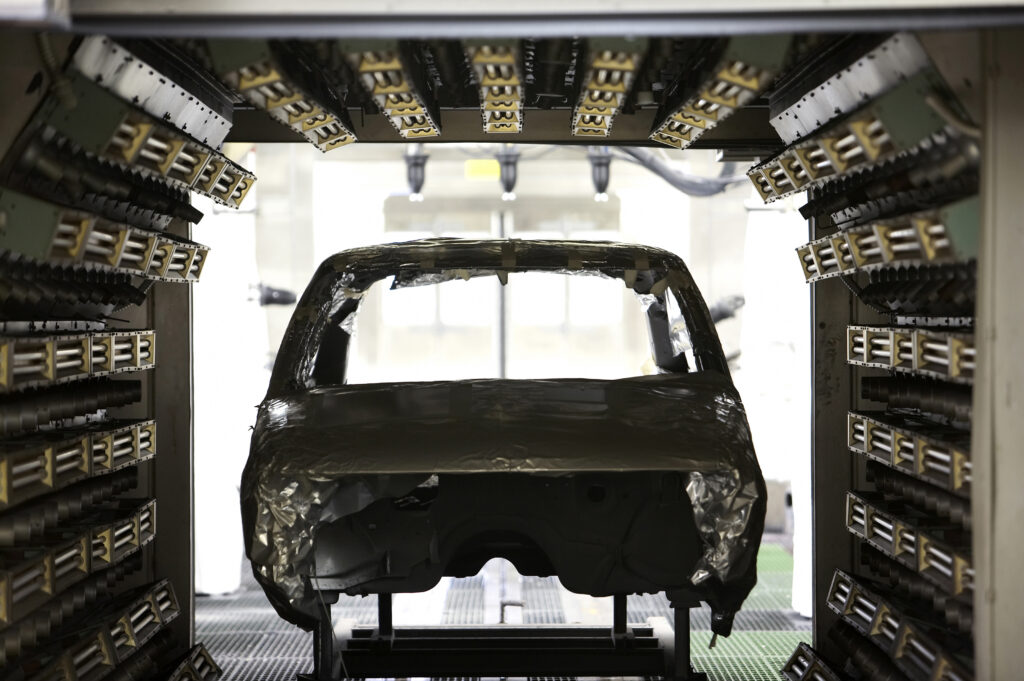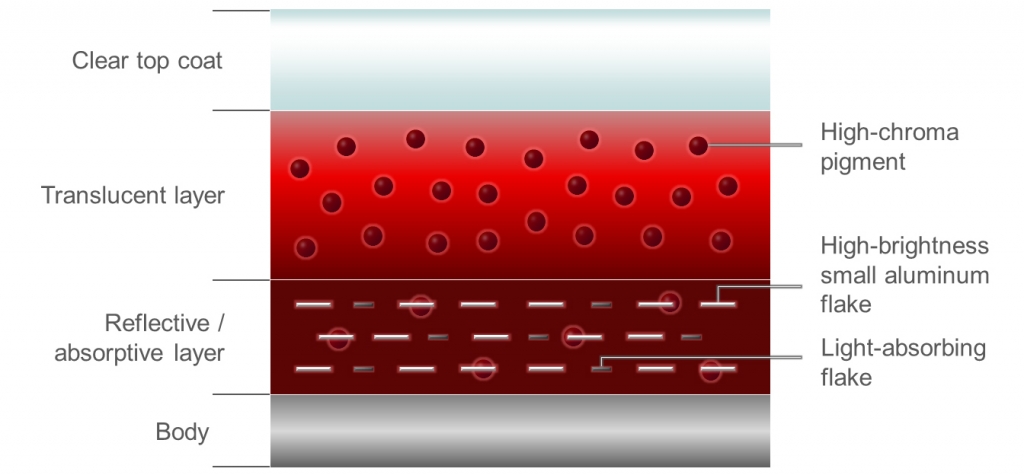
New paint technologies create added considerations for repairers, panel agrees
By onRepair Operations | Technology
With the ever-expanding adoption of radar, lidar, and other advanced driver assistance system (ADAS) technologies, paint and coatings have become a functional part of vehicles, which brings new considerations for collision repairers, a panel of paint industry experts agreed last week.
Researching and following OEM procedures to apply the right materials in the right way is becoming just as important as following manufacturer guidance for welding, or parts replacement, panelists Daniel Benton, global product director of color marketing with Axalta Coating Systems; Andy Hysi, ebusiness manager with AkzoNobel; and Jeff Wildman, BASF’s North American manager of OEM & industry relations agreed during the July 28 CIECA technical webinar, “New Technologies in Paint & Coatings.”
“There’s a lot going on right now … in the development of [coatings] to understand what impacts the radar sensors and the lidar sensors, and which types of colors you can and cannot see with different types of sensors,” Wildman said. “So you see a lot of differences in … the collision side of the business, especially when we talk about how do you apply these coatings properly.”
Benton said a major consideration in paint “permittivity,” a measure of how a radar transmission moves through a material. This can vary depending on something as specific as the frequency used by a radar sensor. “This is not just for full-fledged, autonomous driving, but things like lane departure warnings, those types of things. So the need for being able to use radar and lidar technology … is impacting vehicles today.”
All OEMs are compiling paint and finish guidelines, some that vary by specific model and paint code, panelists noted.
“The information varies by OEM, because each one uses, potentially, different types of sensors, or they’re set up in different ways with different software,” Wildman said. He pointed out that, in certain cases, whether a bumper cover can be repaired or replaced depends on what color it’s painted.
“And in some cases, especially with some of the translucent colors, we may be looking to reflect off of the primer behind the color, rather than the color of the vehicle. So if you’re not applying the right color primers, and are applying too much basecoat, that may not operate properly,” he said.
“I’ve worked with a lot of painters that say, ‘Well, one extra coat, just to make sure I’ve got coverage.’ Well, that one extra coat may cause that radar sensor not to work. So you really need to follow those procedures.”
As with other repairs, panelists directed technicians to the OEMs for guidelines.
“One of the things that collision centers kind of need to wrap their heads around somewhat is that paint’s really a functional part of the vehicle now,” Wildman said. “Like following OEM procedures when you’re welding or replacing parts on a car, you need to do the same thing now with paint, because it really is a functional part of those safety systems.”
One challenge for repairers, Benton said, is in replicating the “very, very thin layers” of paint that can be applied by an OEM. “This makes repair a little more challenging, not just in matching colors, but in applying them. When an OEM is painting on an assembly line, with electrostatic paint, and then you’re you got a guy in a body shop trying to fix it with a hand-held gun, gravity feed, application becomes a big thing. It impacts color match capability and appearance.”
Other factors besides ADAS functionality are affecting paint technology, panelists agreed. Among them are environmental and sustainability considerations, OEMs’ desire for innovative finishes, and the particular needs of electric vehicles (EVs).
Hysi said artificial intelligence (AI) and “big data” are playing an increasing role in the paint industry. “More and more data are being generated that offer a great deal of potential. Similar to other industries, coatings manufacturers are working diligently to ensure a sustainable coatings future, together with customers and other stakeholders.
“In terms of AI usage, specifically in coatings, application scenarios range across the lifecycle. We have the simple smart recommendations. We have generated design, anomaly detection, preventative maintenance. So these are all things that pave the way for how products are designed and produced,” he said.
One driver of change is the movement to use less energy, with coatings that “can be applied at lower energy levels and cured at lower energy levels,” Benton said.
Wildman predicted that UV coatings will become more commonplace, “because they have less environmental impact. They’re more sustainable.” While the UV primers currently used can be cured using a small UV light, “if we have a UV clear, there are no UV lights today that can cover a whole car. So, do you buy the light first, or the clear first? When do those come out?”
Similarly, while “we’ve all moved to waterborne basecoats, there are waterborne primers, and in other markets and in other industries there are waterborne clears. We’ll see those in our industry at some point. I don’t know when exactly, but they’re coming. When those come out, then I can tell you what equipment you might need.”
Benton said the “surge in electric vehicles” is creating a need for specialized finishes, designed with heat dissipation and conductivity in mind.
Wildman expanded on the point. “One of the biggest issues with an electric vehicle is range anxiety. When you run the air conditioner, you use that battery. And if you’re driving a black car in Nevada, your air conditioner’s running. So if we can make that black car reflect some of that heat, less power for the battery [to supply], you know, does that take something different to apply? I don’t know yet.” Such specialized finishes are “all in development, but they haven’t come to the refinish industry yet.”
Aesthetics, too, are driving change. “We’ve seen some really remarkable things recently from manufacturers like Mazda in particular, to pick on them,” Benton said. “They’ve introduced some innovative colors recently …. There’s also some things going on around high-chroma and dispersion technologies. So, I think the need to reach further into the color space to move market share is driving some of these innovations.”
Hysi noted that AI and software integration can help repairers deal with the increasing complexity of finish options.
“There will always be opportunities along the way, driven mainly by customer’s needs,” he said. For instance, he said, repairers could instantly know when a vehicle arrives whether its repair will require rarely-used paint and materials that take time to order.
“Imagine if you could just flag those colors … on the color management software as soon as something comes up, those rarely used colors. So those are things that will always be possible with more integration between the various software companies out there. So it’s anticipated obviously that efficiency, productivity and safety across the paints and coatings supply chain will be improved along with digitization efforts. And these are all driving operational excellence out there,” Hysi said.
“In some cases, we’re seeing new pigments come out and those pigments aren’t available in your traditional mixing system,” Wildman said. “So it’s really important that … when your estimator or your repair planner’s looking at the vehicle, they’re checking that color code, because if it’s if it’s got a limited edition toner, it may take you a week or more to get that into your shop. You don’t want to wait until that car’s in the booth and say, ‘Oh wow, we don’t have this toner,’ and find out it’s gonna take a week to get it. The other side of it is, those toners are not necessarily cheap.
“We hear this all the time — ‘I don’t get paid for that,’ or ‘How do I get paid for that?’ Well, now you’re at the end of the line, you’ve got to tell a customer it’s going to take another week to paint the car, and [you’re] going to spend more money on paint now. If you catch that up front, you can build that into the program. You can set the expectation with your customer, and I think customer experience is something that we’ve got to really focus on more.
“People don’t think about the color and the paint. It’s like, ‘I’ll worry about that when it gets to the booth.’ And that’s what we’ve got to stop doing,” he said.
More information
Panelists explore lidar’s promises, challenges during CIC presentation
Images
Featured image by Group4 Studio/iStock
Participant photos provided by CIECA
A test body moves through the automated paint line at the BASF Coating Applications Research Center in Southfield, Michigan. The line allows technicians to precisely replicate the paint processes and conditions in almost any automotive plant so that they can determine optimum application processes. (Provided by BASF)
A cross-section of Mazda’s Soul Red Crystal Metallic finish. (Provided by Mazda)





